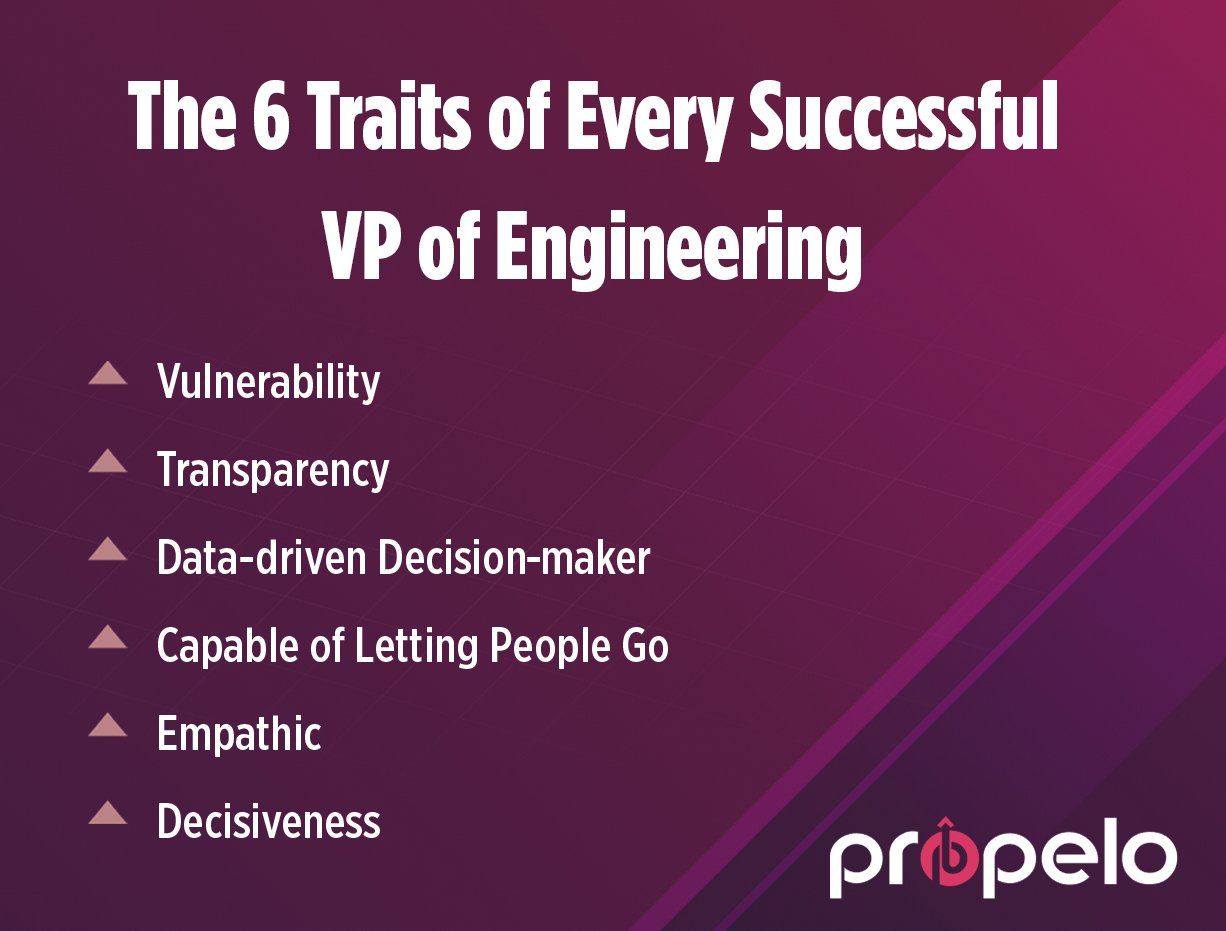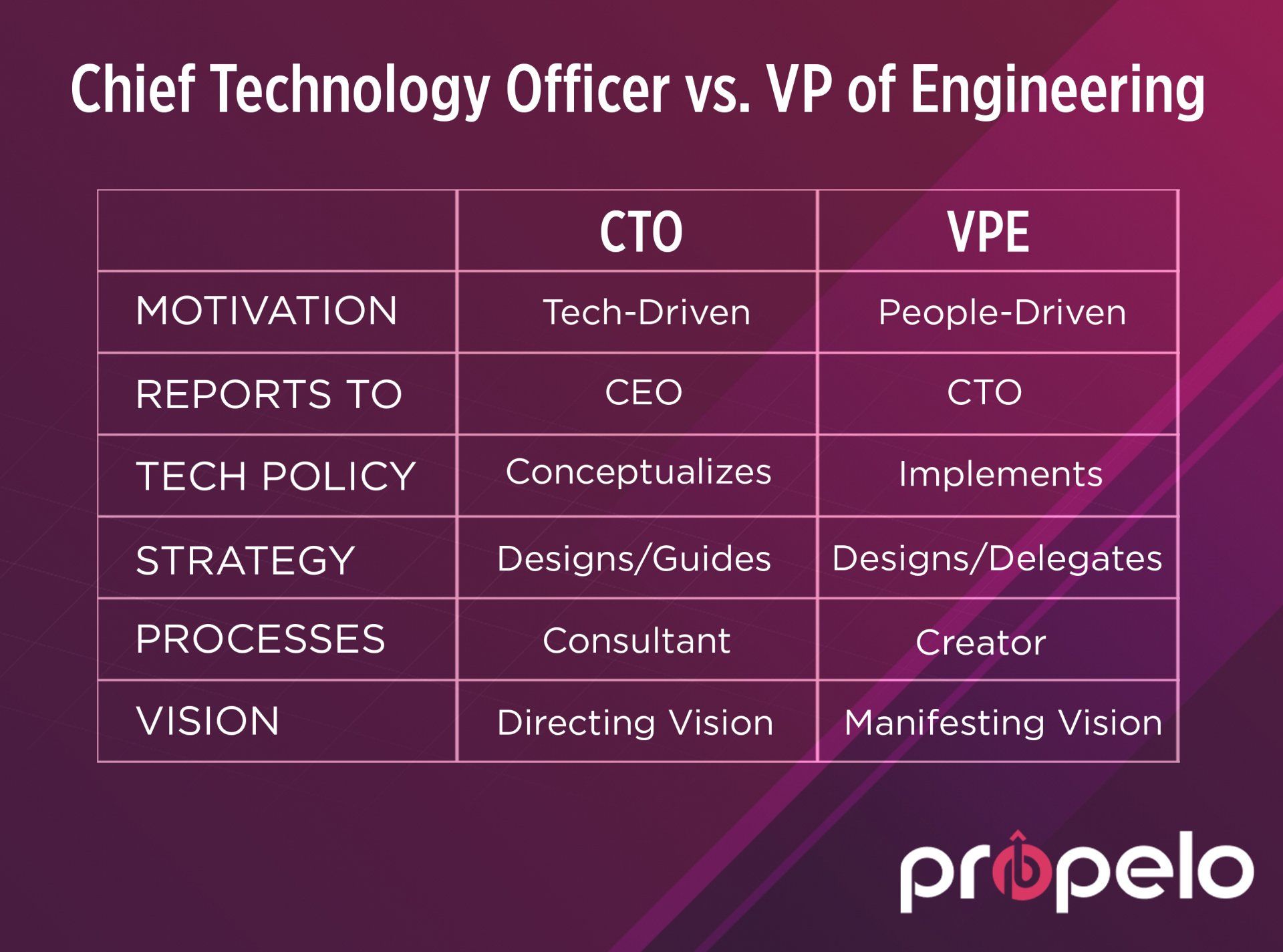
What is the Difference Between a CTO and VP of Engineering?
Previously Published to Propelo.AI on What it means to be VP of Engineering
Constantly raising the bar for innovation, quality and productivity, the success of most engineering organizations depends on the ingenuity of one leader in particular — an advocate for technical teams, a “people person,” and one who leads by example.
The vice president of engineering is someone who’s strong in what BuiltIn calls the ‘people arts’ — arts that include the skillful recruiting, mentoring and coaching of others, the ability to provide structure, define process, and communicate effortlessly with internal stakeholders and customers.
Setting high standards for individual performance, this person works with technical directors and those who manage engineering and development teams. This is someone who empowers the workforce to become more effective as engineers and innovators while harvesting efficiency, impact and productivity through positive reinforcement — hyper-focused on product organization and technical leadership teams.
They’ll keep tabs on the team environment, pushing engineers to set personal goals and to work diligently toward achieving them. They’ll focus on who’s exceeding expectations within the organization and who’s in need of added support — providing opportunities for training and resources that may benefit them.
When something is unclear, they’ll rectify existing policies to amplify the standards that need to be set, eliminating confusion and clarifying expectations between technical and leadership roles across the organization.
On the technical end of the spectrum, this person will go out of their way to ensure that all design requirements are not just met but met with quality and scalability. They oversee the user experience, setting standards for consistent and reliable metrics that ensure that these are met during each and every deployment.
The VP of Engineering in Action: What does a VP of Engineering do?
The vice president of engineering (VPE) is responsible for hiring and retaining engineering, development and DevOp teams, cultivating a culture of collaboration and advancing the organization through technical strategy and innovation.
As for their span of control, the VPE oversees daily workflow activities and provides guidance to technical leadership within the engineering team. They’ll manage multiple projects at once, optimize and allocate budgets for the engineering department. In addition, they’ll plan, coordinate and oversee projects through to deployment, providing direction in the development and implementation of product features and capabilities.

Customer-facing, the VP of Engineering is a technical leader who will represent the product in the public eye. They’ll put their reputation on the line by developing teams they trust and believe in.
The VPE must understand how to build systems and appropriate size processes for their team. Rootstrap points out that as the team grows or shrinks, they can evolve and scale strategies to ensure the team stays on target while making sure products make it to the market on time.
Hyper-focused on industry best practices, they’ll encourage growth through constructive criticism, regular feedback and timely performance evaluations. They oversee offshore development, coordinating the delivery of special projects and managing the efficacy of third-party vendor relations.
The VP of engineering collaborates with executive leadership to develop and meet organizational goals. They’ll act as a subject matter expert on all things technology-related and provide additional guidance on matters related to the business, whether it’s associated with projects, systems or enterprise-level operations.
The VPE will not only identify and recommend new technologies and solutions that could improve internal processes, but he or she will also implement those changes and make last-minute decisions to ensure the seamless transition of system-wide deployment. He or she would also focus on minimizing dependencies and aligning business processes with technical goals and objectives.
The vice president of engineering stays on top of all new technologies, making recommendations where necessary to improve products and architecture. He or she’s the ultimate leader — charismatic, influential and a powerful decision-maker.
The VP of engineering is focused on engineering output and scalability as it relates to development teams. They ensure that all processes run smoothly while serving as a critical liaison between the engineering department, executive-level management and the board of directors. Immersed in growing an authentic engineering culture founded on organization, communication, skill and stability, the VP of Engineering rewards innovation by empowering engineering teams to experiment and stay agile.
Day-to-day interactions may exist through daily scrum meetings and sprint standups, team leadership meetings and spring planning sessions. While it’s not an obligation, the VPE may also attend sprint retrospectives, where their presence alone would be positive and motivational. He or she will provide a unique point of view when identifying critical goals and issues.
What makes a great engineering leader?
The VP of engineering is the spark that ignites creativity. They’ll focus on optimizing their teams and attracting top talent to the organization. They’ll share their vision of what engineering should look like and empower their teams to get there. The VP will hire directors, engineers, developers and even managers while developing highly effective hiring strategies to build out the engineering organization. They’ll encourage developer happiness and express his or her support for experimentation while watching each department evolve into powerhouse teams of experts in the DevOps community.
With a fine mix of technical and interpersonal capabilities, most VPEs have a solid technical background and an infectious personality that breeds inspiration. An excellent communicator, the VP points out why individual roles are important and how their contributions drive impact throughout. He or she will clearly articulate goals for each department and point out how others are uniquely positioned to drive real results.
Building an engineering culture fostered by diversity, inclusivity, support and collaboration, the VP of engineering coaches and influences others while acting as a corporate liaison for insiders, investors, stakeholders and high-profile clientele. The VP tackles some of the most pressing issues among them, patching up conflicts between departments and disconnects in workflow iteration. He or she will work diligently behind the scenes to address some of the most pressing issues within the workforce, removing roadblocks toward progress and asking the right questions to get the right answers.
Playing an important role in shaping the company’s technical strategy, the vice president of engineering must be quick on their feet. They’ll need to keep up with market trends and identify new opportunities for the company. They’ll break through barriers and solve problems by way of industry demand, extensively planning and coordinating strategies for deploying new technologies that heavily appeal to the customer experience.
Setting precedence for what may have the most significant impact on the success of engineering projects, the VPE isn’t afraid to get their hands dirty. They’ll make tough decisions under pressure, going so far as collaborating in the development, testing and troubleshooting of projects, if necessary, to meet tight deadlines and keep high-profile projects on track.
Who does the VP of engineering report to?
In a larger enterprise environment, the VP of engineering generally reports to the chief technology officer (CTO), whereas the CTO reports directly to the CEO his or herself. But in the case of a small business or startup organization, the VP may report to the CEO and take on the roles of CTO and VPE as one.
The role of the VPE, or VPoE, tends to focus on personnel and program management, engineering execution, technical leadership and strategy development.
The VP of Engineering is involved in all aspects of managing development team activities, working hand-in-hand with the CTO to develop technical roadmaps and strategies for the leadership of engineering departments. They’ll delegate these policies to both the director of engineering and management to carry out on their behalf, especially during times of organizational change.
All in all, the scope of responsibility for the VP of engineering also includes the following:
- Collaborating with engineering, product, design, business, marketing and sales teams and introducing new products to the market
- Establishing cross-functional teams and therefore broadening both knowledge and the sphere of influence among departments
- Preparing, optimizing and minimizing budgets, often overseeing the procurement of resources and technologies which may very well be the largest share of the company’s budget
- Recommending new tools and solutions while addressing inefficiencies
- Maintaining high retention rates while minimizing turnover
- Co-owning the technology strategy, teaming up with the CTO to establish the goals and direction of the software engineering department
- Providing 1:1 training, career growth and professional development opportunities
- Celebrating the successes and identifying areas for continuous improvement, pointing out concerns and amplifying the wins as backed up by meaningful metrics
- Improving, expanding and reinforcing company policies, procedures and best practices
- Advocating on behalf of developers and engineering teams, giving everyone a voice and acting in the best interest of others
“If the CTO knows the destination, the VP is identifying the route.”
The VP oversees technical staff and software engineering teams. The exact responsibilities of the VP of engineering will depend on the size, status and culture of the organization.
How does a VP of Engineering get his or her wings?
The vice president of engineering will often have a strong background in engineering, perhaps even spending years in roles such as software engineering, software development or even testing. As a result, they’ll not only have a deep understanding of the software artifacts and catalogs that make up the enterprise architecture, but they’ll also know how to design corporate processes, facilitate governance and maintain developer happiness based on similar principles.
He or she will have worked their way through the ranks, taking on leadership and management roles, starting with taking the lead on various projects. As they learn how to improve the performance of teams, create more efficient processes and achieve developer productivity, this individual is often called to take on more responsibility, earning multiple promotions throughout this course.
They’ll lead and manage DevOps teams and mold a highly productive engineering culture. As they become comfortable with agile work environments and principles such as value stream management and microservices architecture, they’ll move from management roles and into the position of director before eventually being promoted to the role of VP.
One Engineering VP Talks Trains, Timing and His ‘Sphere of Influence’
In a Medium blog, the new Head of International at thredUp, Dan DeMeyere, recounts his early journey to Vice President of Engineering. He quotes Entrepreneur Mark Suster, as he likens the earlier part of his journey to driving trains:
“VPs of Engineering are essential to making sure the trains run on time. VPs of Engineering are essential to making sure the trains run on time and identifying the best way to lay down tracks.”
He later discusses how it became more like timing trains as he moved up the technical ladder:
“When I was a Lead Engineer, it was my goal to tackle challenges by thoughtfully driving collaborative efforts based on everyone’s strengths. While I impacted our processes and culture, my primary focus was influencing outcomes for our team’s projects, moving our tech stack in the right direction, and mentoring engineers.
“Once I transitioned into Director of Engineering, my sphere of influence on the team needed to grow. I was no longer measured by individual contributor heroics or by how successful a string of projects were. I was measured by my ability to build high-performing development teams and consistently deliver results for the business. In other words, getting out of the driver’s seat of the train to enable multiple trains to run concurrently.”
As he aspired to become a better manager, he focused more on the team culture and strengthening the workforce through his choice of new hires. He advocated for greater transparency, more communication and better organization before, ultimately, promoted to VP.
“It doesn’t matter how strong you are technical, how great you are at hiring, or how well you partner with the business,” DeMeyere explained. “If the trains aren’t arriving on time, then you’re failing to deliver on the core responsibility of a VPE. Full stop.”
He finished his blog by quoting the words of Ed Catmull:
“Driving the train doesn’t set its course. The real job is laying the track.”
Effective VPEs are measured by the success of their teams. They’re influencers, they’re trendsetters, and they set the pace for “why” engineering teams do what they do. They’re listeners, actively listening to what’s being said — just as much as what’s going unnoticed. They’re disciplined yet charismatic. It’s their empathy that drives them and their ambition that keeps them charging forward — investing in people and maximizing their sphere of influence over the entire engineering organization.
CTO vs. VP Engineering: What is the difference?
The primary difference between CTO and VP, Engineering is that the chief technology officer has a seat at the top of the executive hierarchy. He or she is part of the C-suite of leadership, making top-tier decisions for the organization.
Focusing specifically on transforming and growing operations relating to technology and internal policies, the CTO develops short- and long-term strategies that impact the company’s overarching technical infrastructure, the quality of technical processes and the performance of technical contributions by engineers and developers within the organization. The CTO also focuses on how these processes align with business-related goals and objectives while cultivating positive client relations and the business’s reputation for excellence.
The chief technology officer (CTO) holds one of the highest and most important roles within an organization and oversees the entire technological infrastructure of the organization — a critical role within an enterprise whose clients depend on solutions that drive their businesses toward success. They’ll regularly report to the CEO and the Board of Directors but team up with VPEs and lean practitioners to grow out and build up the technical department.

The CTO has a deep understanding of infrastructure capabilities and the performance of internal teams as they relate to the design and optimization of technical product lines. He or she is headstrong in finding ways to improve, redevelop and optimize new and existing processes while maintaining technical compliances as they relate to regulations, policies and procedures.
The CTO places emphasis on the design and development of new products, collaborating with the VP of engineering to develop a strategy as it relates to timelines and expectations, scalability and the quality of deliverables at various stages of the software development life cycle (SDLC).
The VP of engineering reports to the CTO and acts as a critical intermediary between C-suite operations and technical teams.
While the VPE’s main focus will be on the indirect oversight of engineers, projects and program management, the VPE will work in synergy with other management team members to develop the company’s technical products and strategy. For example, he or she will delegate the software development and engineering activities while the CTO guides the overall technical strategy to fruition.
The CTO is the technological leader at the company and will be involved in many customer-facing activities, working closely with the rest of the executive leadership team. While they may serve as a key contributor to the corporate blog or maintain the company’s patent portfolio, they have very little interaction with anyone outside the C-suite and VP of engineering but, at times, will work with engineering management teams, architects and research engineers.
The VP, however, will play a major hand in the management of both engineering and development teams. They’ll also be engaged in executive-level operations, as it relates to forging solid client relations, optimizing department budgets and establishing untouchable engineering excellence. In addition, they’re responsible for designing roadmaps that reflect product vision and bring them to life through team leadership and collaboration.
Balancing the struggle between speed and quality, VPEs make sure their developers are happy — optimizing engineering processes, hitting goals and delivering amazing software products.
Aside from that, what does a CTO do?
Most CTOs have a background in software engineering, architecture, data engineering and project management. They have a deep technological understanding of the complexities of innovation and the design process. Still, they can translate these concepts into basic terms for the non-technical audience.
The chief technology officer is often called the “chief product developer.” They’re research-oriented and focused on the overarching and high-level growth of enterprise operations. They’ll lead the company’s technical direction through strategy and vision. They’ll evolve existing policies for technological processes and procedures, improving efficiencies and directing the vision of the engineering culture.
Maintaining their technical edge, the CTO has often worked their way up from the engineering department and managerial roles therein. They’ll continue to engage in the research and oversight of new technologies throughout their careers, sharing years of experience in software development, architecture and engineering excellence.
Research is a major part of being a CTO, and he or she will participate in a fair amount of customer-facing speaking engagements because of it.
Is CTO higher than the VP of Engineering?
The role of chief technology officer is the highest position within the technology and engineering departments. They delegate operational responsibilities to the VP of engineering while acting in the best interest of the board, stakeholders, shareholders, c-level officers and enterprise-level clientele.
Small Enterprise CTO vs Large Enterprise CTO
While the CTO and VP Engineering are clearly two different roles, there are times when lines are blurred, and a single entity will take on both roles. In the case of small enterprises and startups, the CTO and VP are often the same person. As the company grows, a new position will be added. Whether this person starts out as the VP or CTO really depends on the company itself and how they prefer to structure their business.
Most startups, especially those who’ve recently received funding, must consider whether the company is ready to hire both a CTO and a VPE — or if the company is small enough for one person to take on both roles at once.
For some companies, especially small-to-medium-sized enterprises, this will be an important step in moving the company forward at a more rapid pace. Divvying up important tasks and responsibilities between both roles will be key in the growth of the organization but may not be necessary all at once.
At early stage organizations, it’s not uncommon for the VP to wear multiple hats or to prematurely carry the title of CTO while taking on heavier responsibilities than they would at a larger organization. Likewise, a CTO may be hired directly to the c-suite and still act as a VPE in many situations.
There’s a common trend in technology that the CTO will start from within the engineering department and work their way through the ranks —- often acting as the director of engineering, moving into the role of VP until they’re promoted to the role of chief technology officer. As the CTO of a larger organization, they’ll take on a more structured role within the executive suite but lead the technological direction of overall operations, which means they’ll have more freedom for research, development and the spark of ingenuity.
While the CTO at a smaller company, or enterprise, tends to be more operational in nature, as the company grows — or as the CTO joins a larger enterprise, that same CTO will take on a more influential role in the technical direction of the organization. This will involve designing and transforming technical strategies, often collaborating with and providing guidance to the VPE who will, then, delegate these strategies to the engineering and development teams.
The CTO will engage in more creative processes, encouraging engineering teams to engage in more experimental pursuits when directing the overall vision of the organization. He or she will conceptualize new policies based on the changing times and introduction of new technologies and will work with the VPE to implement those policies into the existing policies already adopted by the organization.
The CTO will act as a consultant to the VPE when it comes to the development of new processes, equally focused on the quality of new solutions and the performance of engineering teams.
Is CTO higher than the VP of Engineering?
The role of chief technology officer is the highest position within the technology and engineering departments. They delegate operational responsibilities to the VP of engineering while acting in the best interest of the board, stakeholders, shareholders, c-level officers and enterprise-level clientele.
What’s the difference between the Head of Engineering and a CTO?
While the CTO is responsible for overseeing the organization’s research and technological advancements, as a whole, the head of engineering is instead responsible for those elements that typically fall within the scope of leading the engineering teams.
Not only do they lead entire engineering departments, but head engineers are also in charge of coordinating projects, developing strategy, managing tasks, budgeting and customer relationship management. They’re responsible for overseeing the ongoing progress of engineering teams and managing multiple projects at once — primarily:
- Delegating tasks
- Setting project goals
- Prioritizing deliverables
- Managing timelines
At most organizations, the head of engineering is also the vice president of engineering. But in the case of smaller enterprises and startups, this seat may be occupied by the director of engineering, whereas the vice president of engineering and the CTO are one in the same.
The Director of Engineering vs. The VP of Engineering
In a mid-to-large-sized organization, it’s not rare to have both a director of engineering and a VP of engineering. As is the case, the director of engineering will actually report to the VP while acting as a liaison between technical management and engineering teams.
He or she will be involved in the coaching and mentoring of cross-functional teams while directing the day-to-day operations of the engineering department. The director of engineering focuses on the transformation of teams, developing the engineering culture and optimizing the workforce.
The director of engineering will manage the “how” of daily workflow activities to ensure that all projects stay on target, under budget and exceed client expectations — while the VP focuses on developing strategies that meet the “why” of product creation.
What’s a VP of Data Engineering? Is it a new job title or role?
The vice president of data engineering and the vice president of engineering are two different roles. The VP of data engineering is actually a new role we’re starting to see in data-driven organizations, whereas the role of VP of Engineering usually relates to software engineering, software development and engineering-related analytics.
Read on.
Check out the Six Traits Behind Every Successful VP of Engineering by Sumeet Arora, Chief Development Officer at ThoughtSpot.


